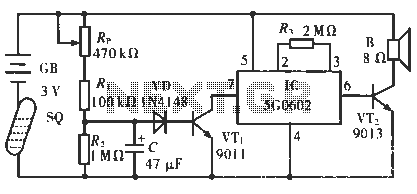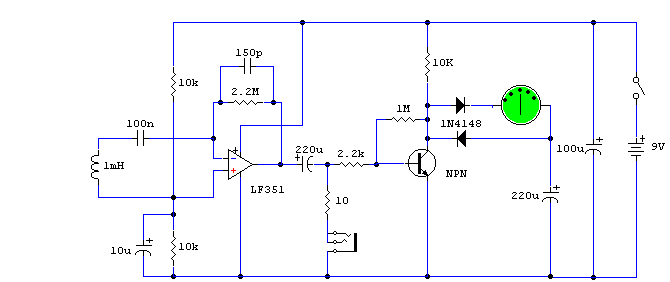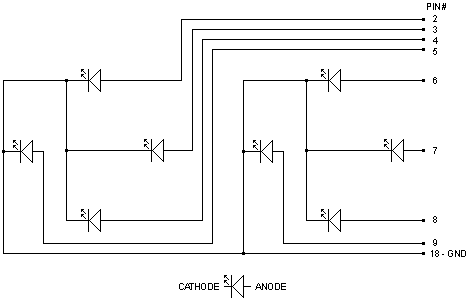
Rain detector alarm

This circuit gives out an alarm when its sensor is wetted by water. A 555 astable multivibrator is used here which gives a tone of about 1kHz upon detecting water. The sensor when wetted by water completes the circuit and makes the 555 oscillate at about 1kHz.
The sensor is designed to activate an alarm system when moisture is detected, utilizing a 555 timer configured in astable mode. The frequency of oscillation is approximately 1 kHz, which produces an audible tone to alert users of the presence of water. The sensor is strategically positioned at an angle of 30 to 45 degrees relative to the ground. This orientation allows rainwater to flow off the sensor, minimizing false alarms that may occur from water pooling on the surface.
The sensor is constructed from aluminum, which is preferred over copper due to the latter's tendency to develop a blue oxide layer when exposed to moisture. This oxide can impede the sensor's functionality and requires regular maintenance to clean. The aluminum sensor can be mounted on a wooden or plastic base using epoxy adhesive or small screws, ensuring a secure installation.
Electrical connections from the sensor, designated as contacts X and Y, can be achieved using small crocodile clips or screws. This design not only enhances the reliability of the circuit but also simplifies maintenance and adjustments. The overall circuit is designed to be straightforward, allowing for easy assembly and deployment in various environments where water detection is necessary.This circuit gives out an alarm when its sensor is wetted by water. A 555 astable multivibrator is used here which gives a tone of about 1kHz upon detecting water. The sensor when wetted by water completes the circuit and makes the 555 oscillate at about 1kHz. The sensor is also shown in the circuit diagram. It has to placed making an angle of about 30 - 45 degrees to the ground. This makes the rain water to flow through it to the ground and prevents the alarm from going on due to the stored water on the sensor. The metal used to make the sensor has to be aluminium and not copper. This is because copper forms a blue oxide on its layer on prolonged exposure to moisture and has to be cleaned regularly. The aluminium foils may be secured to the wooden / plastic board via epoxy adhesive or small screws. The contact X and Y from the sensor may be obtained by small crocodile clips or you may use screws. 🔗 External reference
The sensor is designed to activate an alarm system when moisture is detected, utilizing a 555 timer configured in astable mode. The frequency of oscillation is approximately 1 kHz, which produces an audible tone to alert users of the presence of water. The sensor is strategically positioned at an angle of 30 to 45 degrees relative to the ground. This orientation allows rainwater to flow off the sensor, minimizing false alarms that may occur from water pooling on the surface.
The sensor is constructed from aluminum, which is preferred over copper due to the latter's tendency to develop a blue oxide layer when exposed to moisture. This oxide can impede the sensor's functionality and requires regular maintenance to clean. The aluminum sensor can be mounted on a wooden or plastic base using epoxy adhesive or small screws, ensuring a secure installation.
Electrical connections from the sensor, designated as contacts X and Y, can be achieved using small crocodile clips or screws. This design not only enhances the reliability of the circuit but also simplifies maintenance and adjustments. The overall circuit is designed to be straightforward, allowing for easy assembly and deployment in various environments where water detection is necessary.This circuit gives out an alarm when its sensor is wetted by water. A 555 astable multivibrator is used here which gives a tone of about 1kHz upon detecting water. The sensor when wetted by water completes the circuit and makes the 555 oscillate at about 1kHz. The sensor is also shown in the circuit diagram. It has to placed making an angle of about 30 - 45 degrees to the ground. This makes the rain water to flow through it to the ground and prevents the alarm from going on due to the stored water on the sensor. The metal used to make the sensor has to be aluminium and not copper. This is because copper forms a blue oxide on its layer on prolonged exposure to moisture and has to be cleaned regularly. The aluminium foils may be secured to the wooden / plastic board via epoxy adhesive or small screws. The contact X and Y from the sensor may be obtained by small crocodile clips or you may use screws. 🔗 External reference





